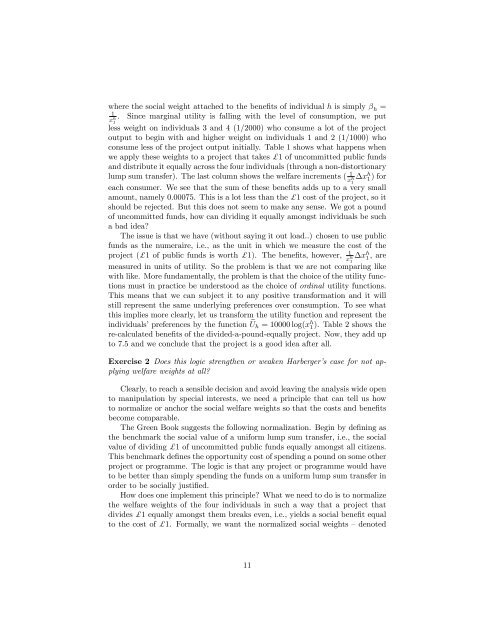Lecture Note 15: Social Cost Benefit Analysis - University of ...
Lecture Note 15: Social Cost Benefit Analysis - University of ...
Lecture Note 15: Social Cost Benefit Analysis - University of ...
You also want an ePaper? Increase the reach of your titles
YUMPU automatically turns print PDFs into web optimized ePapers that Google loves.
where the social weight attached to the bene…ts <strong>of</strong> individual h is simply h =<br />
. Since marginal utility is falling with the level <strong>of</strong> consumption, we put<br />
1<br />
x h 1<br />
less weight on individuals 3 and 4 (1=2000) who consume a lot <strong>of</strong> the project<br />
output to begin with and higher weight on individuals 1 and 2 (1=1000) who<br />
consume less <strong>of</strong> the project output initially. Table 1 shows what happens when<br />
we apply these weights to a project that takes $1 <strong>of</strong> uncommitted public funds<br />
and distribute it equally across the four individuals (through a non-distortionary<br />
lump sum transfer). The last column shows the welfare increments ( 1<br />
xh x<br />
1<br />
h 1) for<br />
each consumer. We see that the sum <strong>of</strong> these bene…ts adds up to a very small<br />
amount, namely 0:00075. This is a lot less than the $1 cost <strong>of</strong> the project, so it<br />
should be rejected. But this does not seem to make any sense. We got a pound<br />
<strong>of</strong> uncommitted funds, how can dividing it equally amongst individuals be such<br />
a bad idea?<br />
The issue is that we have (without saying it out load..) chosen to use public<br />
funds as the numeraire, i.e., as the unit in which we measure the cost <strong>of</strong> the<br />
project ($1 <strong>of</strong> public funds is worth $1). The bene…ts, however, 1<br />
xh x<br />
1<br />
h 1, are<br />
measured in units <strong>of</strong> utility. So the problem is that we are not comparing like<br />
with like. More fundamentally, the problem is that the choice <strong>of</strong> the utility functions<br />
must in practice be understood as the choice <strong>of</strong> ordinal utility functions.<br />
This means that we can subject it to any positive transformation and it will<br />
still represent the same underlying preferences over consumption. To see what<br />
this implies more clearly, let us transform the utility function and represent the<br />
individuals’preferences by the function e Uh = 10000 log(xh 1). Table 2 shows the<br />
re-calculated bene…ts <strong>of</strong> the divided-a-pound-equally project. Now, they add up<br />
to 7:5 and we conclude that the project is a good idea after all.<br />
Exercise 2 Does this logic strengthen or weaken Harberger’s case for not applying<br />
welfare weights at all?<br />
Clearly, to reach a sensible decision and avoid leaving the analysis wide open<br />
to manipulation by special interests, we need a principle that can tell us how<br />
to normalize or anchor the social welfare weights so that the costs and bene…ts<br />
become comparable.<br />
The Green Book suggests the following normalization. Begin by de…ning as<br />
the benchmark the social value <strong>of</strong> a uniform lump sum transfer, i.e., the social<br />
value <strong>of</strong> dividing $1 <strong>of</strong> uncommitted public funds equally amongst all citizens.<br />
This benchmark de…nes the opportunity cost <strong>of</strong> spending a pound on some other<br />
project or programme. The logic is that any project or programme would have<br />
to be better than simply spending the funds on a uniform lump sum transfer in<br />
order to be socially justi…ed.<br />
How does one implement this principle? What we need to do is to normalize<br />
the welfare weights <strong>of</strong> the four individuals in such a way that a project that<br />
divides $1 equally amongst them breaks even, i.e., yields a social bene…t equal<br />
to the cost <strong>of</strong> $1. Formally, we want the normalized social weights –denoted<br />
11


